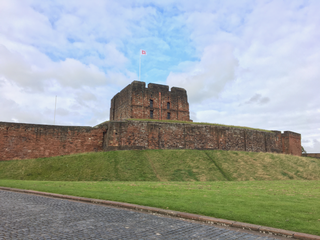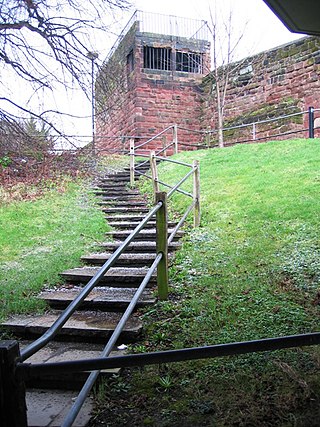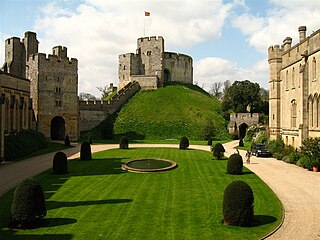
The First English Civil War took place in England and Wales from 1642 to 1646. It is part of the 1639 to 1653 Wars of the Three Kingdoms, which also include the Bishops' Wars, the Irish Confederate Wars, the Second English Civil War, the 1650 to 1652 Anglo-Scottish War and the Cromwellian conquest of Ireland. Historians calculate some 15% to 20% of all adult males in England and Wales served in the military between 1639 and 1653, while around 4% of the total population died from war-related cause, versus 2.23% in World War I. These figures illustrate the impact of the conflict on society in general, and the bitterness it engendered.

The Second Battle of Newbury was a battle of the First English Civil War fought on 27 October 1644, in Speen, adjoining Newbury in Berkshire. The battle was fought close to the site of the First Battle of Newbury, which took place in late September the previous year.

The city of Waterford in southeastern Ireland was besieged twice during 1649 and 1650 during the Cromwellian conquest of Ireland. The town was held by Irish Confederate Catholic under General Richard Farrell and English Royalist troops under general Thomas Preston. It was besieged by English Parliamentarians under Oliver Cromwell, Michael Jones and Henry Ireton.

The siege of Carlisle occurred during the First English Civil War when the allied forces of the Scottish Covenanters and the English Parliamentarians besieged Carlisle Castle which was held at the time by the English Royalist forces loyal to King Charles I. The siege took place in Carlisle, Cumbria from October 1644 to 25 June 1645.

The second and longest siege of Worcester took place towards the end of the First English Civil War, when Parliamentary forces under the command of Thomas Rainsborough besieged the city of Worcester, accepting the capitulation of the Royalist defenders on 22 July. The next day the Royalists formally surrendered possession of the city and the Parliamentarians entered Worcester 63 days after the siege began.
The siege of Gloucester took place between 10 August and 5 September 1643 during the First English Civil War. It was part of a Royalist campaign led by King Charles I to take control of the Severn Valley from the Parliamentarians. Following the costly storming of Bristol on 26 July, Charles invested Gloucester in the hope that a show of force would prompt it to surrender quickly and without bloodshed. When the city, under the governorship of Lieutenant-Colonel Edward Massey, refused, the Royalists attempted to bombard it into submission. Massey adopted an aggressive defence, and the Royalist positions outside the city were regularly disrupted by Parliamentarian raids. The Royalist artillery proved inadequate for the task of siege work and, faced with a shortage of ammunition, the besiegers attempted to breach the city walls by mining. With Royalist miners about to reach the city's east gate and the defenders critically low on gunpowder, a Parliamentarian army led by the Earl of Essex arrived and forced Charles to lift the siege.
The siege of Reading was an eleven-day blockade of Reading, Berkshire, during the First English Civil War. Reading had been garrisoned by the Royalists in November 1642, and held 3,300 soldiers under the command of Sir Arthur Aston. On 14 April 1643, Robert Devereux, 3rd Earl of Essex brought a Parliamentarian army of 19,000 men to lay siege to the town, and began bombarding the town two days later.

Worcestershire was the county where the first battle and last battle of the English Civil War took place. The first battle, the Battle of Powick Bridge, fought on 23 September 1642, was a cavalry skirmish and a victory for the Royalists (Cavaliers). The final battle, the battle of Worcester, fought on 3 September 1651, was decisive and ended the war with a Parliamentary (Roundhead) victory and King Charles II a wanted fugitive.
Christopher Lewknor was an English politician who sat in the House of Commons variously between 1628 and 1641. He supported the Royalist side in the English Civil War.

William Ogle, 1st Viscount Ogle was an English soldier from Northumberland who settled in Hampshire and was Member of Parliament for Winchester from 1640 to 1643. He served in a number of wars and was Royalist governor of Winchester from 1643 to 1645.

Sir Edward Ford, 22 April 1605 to 3 September 1670, was a member of the West Sussex gentry and inventor, who fought for the Royalists in the Wars of the Three Kingdoms. In his "History of the Rebellion", Clarendon judged that while 'a man of honesty and courage', Ford lacked experience of war and was an ineffectual soldier. However, he proved a reliable and trustworthy agent during negotiations between Charles I and Parliament in the period leading up to the 1648 Second English Civil War.

During the English Civil War (1642–1651), Bristol was a key port on the west coast of England and considered strategically important by both Royalists and Parliamentarians. Initially, the leadership of Bristol wanted to keep the city neutral in the conflict. In 1642, city officials implored Thomas Essex not to occupy the city with his Parliamentarian forces. The city was weakly defended, and Essex entered without much resistance. During the conflict, Bristol was used as a receiving point for the Royalists to accept reinforcements from Ireland. The town was well fortified by the Frome and Avon rivers, as well as a medieval castle, which had been bought by the corporation when the First English Civil War broke out in 1642, and during the Parliamentary defense, earthen artillery forts.

The siege of Chester occurred over a 16-month period between September 1644 and February 1646 during the First English Civil War. In the engagement, Sir William Brereton and the Parliamentarians were ultimately successful in taking possession of the city and Royalist garrison commanded by Lord Byron.
The siege of Portsmouth was the siege of a Royalist garrison in Portsmouth by a Parliamentarian force conducted in the early part of the First English Civil War. The siege resulted in Portsmouth falling to Parliament after a little under a month of conflict.

The Storming of Farnham Castle occurred on 1 December 1642, during the early stages of the First English Civil War, when a Parliamentarian force attacked the Royalist garrison at Farnham Castle in Surrey. Sir John Denham had taken possession of the castle for the Royalists in mid-November, but after the Royalists had been turned back from London at the Battle of Turnham Green, a Parliamentarian force under the command of Sir William Waller approached the castle. After Denham refused to surrender, Waller's forces successfully stormed the castle. They captured it in under three hours, mostly due to the unwillingness of the Royalist troops to fight. This allowed the Parliamentarians to get close enough to breach the gates, after which the garrison surrendered.

The Battle of Muster Green was a minor battle of major significance that took place during the first week of December 1642 on and around the then much larger Muster Green in Haywards Heath during the first year of the First English Civil War. A Royalist army under Colonel Edward Ford, High Sheriff of Sussex, marching from Chichester to seize Lewes for the King encountered a smaller but more disciplined Parliamentarian army under Colonel Herbert Morley waiting for them on Muster Green.

The siege of Arundel took place during the First English Civil War, from 19 December 1643 to 6 January 1644, when a Royalist garrison surrendered to a Parliamentarian army under Sir William Waller.

The Battle of Bramber Bridge was a minor skirmish that took place on 13 December 1643, during the First English Civil War. A Royalist detachment from Arundel attempted to secure the bridge over the River Adur at Bramber in West Sussex, but found a Parliamentarian force already in possession.

The siege of Exeter (1642) or First Siege of Exeter took place during the First English Civil War from late December 1642 to early January 1643 when Royalists led by Sir Ralph Hopton attempted to capture the port of Exeter from the Parliamentarians.
The Sussex Militia was an auxiliary military force in Sussex on the South Coast of England. From their formal organisation as Trained Bands in 1572 they defended the coastline, watched the Spanish Armada and took an active part in the English Civil War. It was the Sussex Militia who captured the Duke of Monmouth after his unsuccessful Rebellion in 1685. After a long hiatus, the Sussex Militia was reformed in 1778 and provided internal security and home defence in all of Britain's major wars thereafter. It eventually became the Royal Sussex Light Infantry Militia (RSLIM) and also formed the Royal Sussex Militia Artillery. After the Cardwell Reforms the RSLIM became a battalion of the Royal Sussex Regiment and saw active service in the Second Boer War. It served as a Special Reserve training unit in World War I. After 1921 the militia had only a shadowy existence until its final abolition in 1953.
















